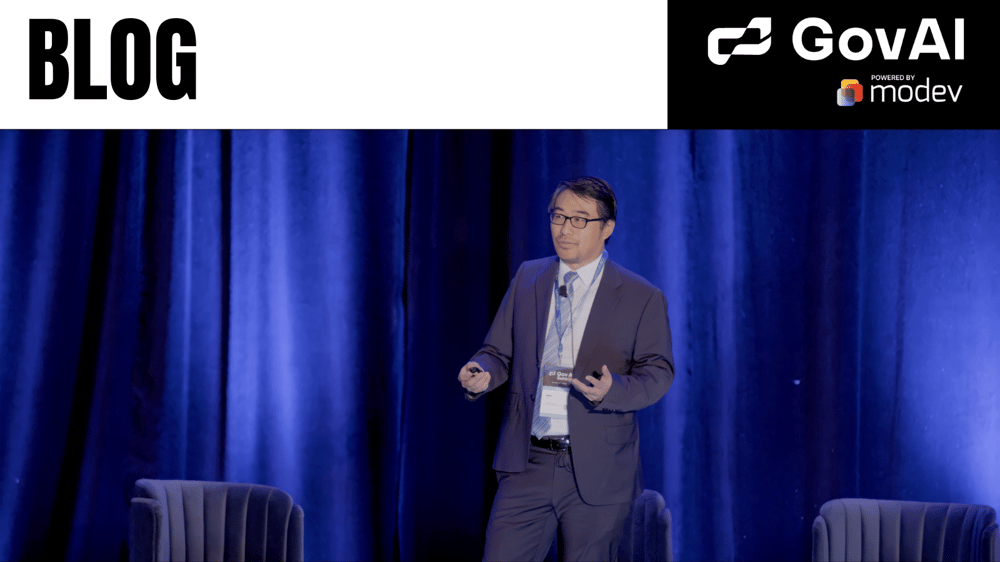How The CDC's Strategic Integration of AI is Transforming Public Health
Modev News govai 24-03-1 Modev Staff Writers 4 min read

A Roadmap to Innovation and Responsibility
In the ever-evolving landscape of artificial intelligence (AI), public health organizations like the CDC are at the forefront. They're integrating this new technology to tackle society's most pressing health challenges. At the GovAI Summit, we were joined by Alan Sim, an epidemiologist by background who serves as the CDC's Chief Data Officer, to share his insights and strategies that can guide others in the field.
In this post, we look at the four key points of his talk, which also happen to be the areas of focus shaping the CDC's approach to AI and ML infrastructure development.
Let's get started.
Prioritizing Problem-Solving Over Technology
The allure of cutting-edge technology can often overshadow the fundamental goal of solving real-world problems. A prime example of this principle in action is the CDC's targeted approach to suicide prevention.
The seductive nature of the newest gadgets and algorithms can sometimes lead organizations to adopt technology for its own sake rather than for the tangible benefits it can deliver to the communities they serve. By leveraging AI to analyze data and identify patterns, the CDC aims to develop proactive interventions rather than simply investing in the latest tech without a clear purpose. This problem-centric approach ensures that technology is a means to an end, not the end itself.
The proactive interventions developed from AI analysis are not one-size-fits-all but are instead driven by the specific needs and nuances of the problem at hand. This could mean personalized outreach programs, community-based prevention strategies, or targeted mental health services. The key, he continues, is that the technology amplifies and enhances the effectiveness of these interventions rather than being the centerpiece.
The Power of AI Use Cases
Building upon the above, AI's potential in public health is best illustrated through concrete use cases. As such, the CDC's 'Hamlet' project is a testament to this. By applying computer vision algorithms to X-ray images, the system can quickly identify signs of tuberculosis, which might be missed or take longer to be recognized by human eyes. This not only speeds up the diagnostic process but also increases its accuracy, leading to earlier and more effective treatment for patients.
Similarly, 'Towerscout' represents another innovative use of AI that illustrates the technology's potential in environmental health. By analyzing satellite imagery to locate cooling towers, which are potential breeding grounds for the bacteria that cause Legionnaires' disease, public health officials can monitor these sites for proper maintenance and quickly respond to any signs of an outbreak. This proactive approach is crucial for preventing the spread of the disease, which can be fatal if not addressed swiftly.
Alan feels these practical applications of AI underscore its role as a valuable tool in disease detection and response - and we'd have to agree!
Crafting a Strategic AI Framework
The CDC's strategic approach to A is a forward-thinking model emphasizing the importance of a structured and collaborative environment for successfully integrating AI technologies in public health initiatives. At the core of this strategy lies a comprehensive AI roadmap, which serves as a blueprint that guides the agency through the complexities of AI adoption, ensuring that each step is purposeful and contributes to the overarching mission of better public health outcomes.
Integral to this roadmap is the establishment of a community of practice. This community is a dynamic collective where data scientists and AI practitioners across the CDC can share their experiences, insights, and best practices. The exchange of AI use cases within this community is particularly beneficial, as it allows members to learn from real-world applications, understand the practical implications of AI technologies, and appreciate the nuances of their deployment in public health settings.
Complimentary to the above, an AI/ML consultation group further supports these efforts, offering expertise and guidance to ensure AI projects are aligned with organizational goals and ethical considerations. Together, the AI roadmap, community of practice, and AI/ML consultation group create a robust framework for advancing AI within the CDC while contributing positively to the agency's mission of protecting public health.
Addressing the Ethical Challenges of AI
Ensuring transparency and avoiding bias are AI's most critical ethical challenges. Generative AI and its ability to create content that can be indistinguishable from that produced by humans presents a significant risk of propagating biased or inaccurate information, which could lead to severe health risks if not carefully managed. That's why, Alan tells us, the CDC's emphasis on source verification is so critical.
Ethics in AI are also about fostering an environment where AI tools are used to their fullest potential to improve public health outcomes. That means putting AI models through rigorous testing and validation to ensure they are not perpetuating existing biases, which could lead to unequal health services or misinformed public health policies. It also means creating transparent AI systems where the decision-making processes are understandable to users and stakeholders, thereby building trust and confidence in the technology.
Wrap Up
Alan's talk highlights the CDC's balanced approach to AI in public health, where innovation is matched with responsibility and scalability. By focusing on problem-solving, leveraging practical use cases, establishing strategic frameworks, and addressing ethical challenges, organizations can harness the power of AI to make significant strides in public health while maintaining public trust and ensuring equitable outcomes.
Because it's no longer a question of whether AI will be put to use in health care; it's a question of how. And the CDC is pioneering its safe deployment and use.